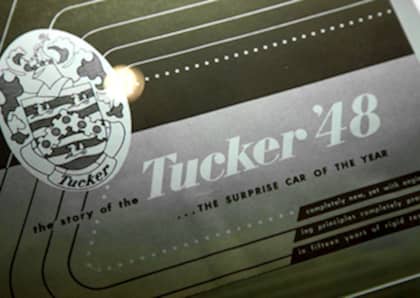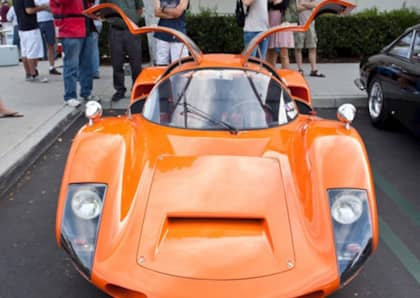The World’s Largest Tucker Collection: The Legacy Lives On
We were invited to cover the grand opening of the Cammack Tucker Gallery at the AACA Museum in Hershey, Pennsylvania, October 2014 — and we were ecstatic. We at Driving Line really love the Tucker.

And why not?
These were such fantastic automobiles — decades ahead of their time in so many ways. Plus, the story of how Preston Tucker was railroaded by powerful conglomerates and their pet politicians is so fascinating that Francis Ford Coppola was compelled to make an entire movie about it.
Unfortunately, the death of the corporation meant that, including the prototype, only 51 Tucker 48s were ever built at the factory. These cars were made so well that, 66 years after they were built, 47 of them still remain, even though several of them were used as race cars in the 1950s; Tucker #1027, met its demise at Indianapolis Motor Speedway during testing.
Preston Tucker was very meticulous. He had plans and blueprints and prototypes for everything. After all, he was building “the first new car in 50 years.” In order to get his cars out there on schedule, he did what many smaller (and even larger) manufacturers did: He borrowed from other manufacturers.
Tucker designed and built a 589 ci engine with direct drive torque converters, but the design failed during the unveiling of the car because it was rushed to market. He later replaced it with a Franklin O-335 helicopter engine. Unlike the Cord transmission that he used in some of the prototypes, Preston Tucker owned the Franklin company that manufactured those engines.
Tucker ultimately wanted his cars to have no transmissions; rather, he designed his engines to be direct drive, powering torque converters without the use of a transmission. However, Tucker did design and build two types of transmissions: the Y-1 manual and the “Tuckermatic” automatic.
There were only two automatic transmissions made at the Tucker factory, and now they are both part of the exhibit. One of the two “Tuckermatic” trannies went into Tucker #1026, which is one of the three Tuckers on display in this exhibit. Because of this feature, it has been called the most valuable Tucker of all.
The other Tuckermatic went into #1042, one of the four deceased Tuckers (or at least, it's assumed to be gone). This Tucker — sold at the factory bankruptcy auction without a powerplant — went missing in the 1950s until being spotted along a bank of the Mississippi River by police in Tennessee. One of the officers that found it took possession of the car, but when he returned home from a stay in the hospital, learned that it had been stolen. The car was probably destroyed, although that has never been proven. However, the transmission (excluding the front torque converter) was eventually recovered and mated to the engine it never knew. This powertrain is on display at the Tucker Exhibit.
There are multiple Tucker engines on display. There is one other engine/transmission combination — that being a Franklin motor and Cord 810 transmission, complete with radiator, carburetor, electric transmission solenoids and axial-type air conditioning compressor. Most of the engines on display are Franklins, but the exhibit also includes the first Tucker factory-built engine.
Almost as cool is the beyond-life-size 32x5-foot wraparound poster of the engine shop at the Tucker factory that is on display behind these units. To see just how revolutionary the Tucker was in its day, the center of the gallery has two complete rolling chassis: a Tucker and a Cadillac, the most advanced factory-produced car of the time.
This exhibit is not just about the cars. Preston Tucker’s story is very much a human-interest story as it tells the tale of a self-taught automotive engineer who chose to be different and fight the establishment. Even though he eventually lost, Tucker stood up for that in which he believed. He believed that America was ready for a new type of car, but more than that, a new way of thinking.
The “Big 3” had become very set in their ways after nearly 50 years of owning the auto industry and handily crushing any upstarts that could make it past their own lack of business acumen. But Tucker’s upstart was different: He envisioned cars that bucked the norm, with front wheel drive, rear engines, moving headlights, seat belts and so much more.
Moreover, he was a salesman and a showman and people believed the charismatic self-taught engineer. He and his designers, George Lawson and Alex Tremulis, knew that aerodynamic cars were not only the future of the automobile, but also the cars that people wanted to drive in the post-WWII era. Low, sleek, fast and fuel efficient were hallmarks of the Tucker cars.
Rather than attempt to fight Tucker in the court of public opinion by building cars to compete directly with Tucker, the Big 3 chose to fight him in the court system, by having their lackeys in Washington trump up charges against Tucker. Although it was proven in court that Tucker never intended to dupe his investors, the court battle bankrupted the company, and his investors were subsequently duped because of the prosecution. The company was gone, but the legend — and the legacy — lives on.
After a champagne reception, AACA Museum Executive Director Mark Lizewskie addressed the crowd — or at least those who were able to cram their way into the room of the ribbon-cutting ceremony. The museum is a massive building that houses almost two dozen antique buses on its bottom floor along with dozens of cars and other exhibits; all three floors were packed with people during this gala. Lizewskie introduced John Tucker, Jr., grandson of Preston Tucker, who subsequently invited his sons Mike and Sean to the podium, as well as Rob and Bob Ida, whose contributions to the Tucker legacy are vastly important.
Next, Lizewskie introduced the crowd to Rochelle Robinson, who is the Exhibit Programs Director of the AACA Museum and the one who put the gallery together in time for the AACA’s Eastern Regional Fall Meet. Finally, Bill Smith, a volunteer with the museum was brought to the fore to cut the ribbon.
Bill was instrumental in having his friend, David Cammack, donate the entire exhibit to the museum upon the event of his death. Cammack was a huge fan of the Tucker. He first purchased car #1022 more than 40 years ago and loved it — and the Tucker legend — so much that he went on to buy #1001 and finally, in the 1970s, #1026, complete with Tuckermatic transmission in the mid-1970s. But he didn’t just buy cars.
As you can see, he also bought a lot of parts. The engines and transmissions and breakdowns that are on display all came from Cammack’s collection, as did many blueprints, drawings, radios and so much more. Although the AACA has had this collection for over a year, they still haven’t had the time to sort through all of the material that the Cammack estate provided.
By way of both interactive as well as static displays, visitors to the AACA Museum’s permanent Tucker gallery get to learn about Preston Tucker’s life, his successes and the demise of his company. They also get to see a slice of life in 1948.
One of the set pieces is a replica of Tucker’s office that includes the original door from Preston Tucker’s barn. On the opposite side of the exhibit hall is a Tucker dealership; sorry, but they are no longer taking orders for original Tucker 48s! However, you may be able to buy a new Tucker 48 repro from Rob Ida, who along with his father, Bob Ida, is currently working on a one-off reproduction of the Tucker Torpedo — the concept car that Tucker never produced.
(Pictured below: Ty and Dominick Tucker in the AACA's reproduction of a Tucker dealership sales office)
Back at the Ida shop, the Tucker Torpedo is presently taking shape. When asked how long until the custom build will be completed, Rob had no firm answer, saying only that it will be “a while.” Joining Rob and Bob in the manufacturing on this custom car are Mike and Sean Tucker, great-grandsons of Preston Tucker, along with their father, John Tucker. These three were also instrumental in the manufacturing of the Idas’s “Lower 48” reproduction of the Tucker 48, which graced the front entrance of the AACA Museum throughout much of 2013.
Just as Preston Tucker and designer George Lawson envisioned, the Torpedo will have an air-cooled rear-mounted six-cylinder engine, albeit one of German design.
“We’re putting in a Porsche 964 engine," Sean Tucker explained. "We were hoping to stretch the chassis of the Porsche to make the Torpedo, but we’ve decided to build a custom (frame) instead.” Building this car from Bob Ida’s CAD drawings and based on a 1:4 scale model, it is a painstaking job of crafting most parts by hand. Rob Ida told us that his father is currently making the steering wheel that Preston Tucker himself designed and envisioned for the cars that bore his name.
Said Mike Tucker of the car on which his family and the Idas are working:
“The car’s going to be great for the family, the story and to keep the legacy going.”
Watch video of the ribbon cutting ceremony below...
And stop by www.aacamuseum.org/tucker for more information on visiting this amazing exhibit for yourself.























